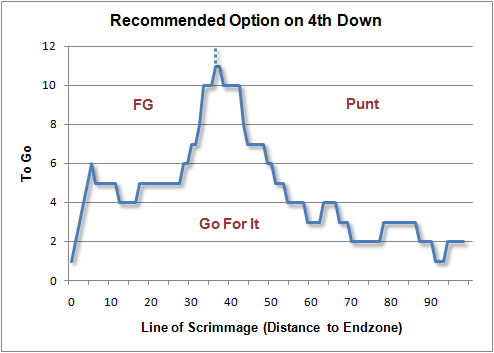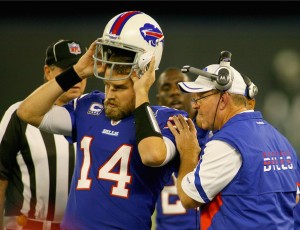On November 25th, trailing the Atlanta Falcons 24-23, the Buccaneers had the ball on 4th and 7 from the Atlanta 38-yard line with just over three minutes remaining. Greg Schiano had all his timeouts left but faced a very difficult decision.
On Sunday, with 12 minutes remaining and a 12-7 lead, Chan Gailey’s Bills faced a 4th-and-7 from the St. Louis 34-yard-line. It’s worth noting — in part because it was notable to Gailey — that minutes earlier, Buffalo scored a touchdown but Shawn Powell botched the extra point, preventing Buffalo from going up 13-7. I suppose we could dwell on the fact that up 5 with 20 minutes left in the game after scoring a touchdown is an obvious scenario that calls for going for two, but let’s not do that in this post.
In Tampa Bay, Schiano attempted a 56-yard field goal. In Buffalo, with rain but wind at his back, the Bills sent on the field goal unit but then changed their mind and chose to punt, with the botched snap from minutes earlier apparently being a factor in the decision.
Who was right? Who was wrong? If you think this post is just a bunch of words I needed to type to show off a really cool graphic, you’re right. Take a look at this chart Brian Burke made to tell you what to do on 4th down generally:

At the 35-yard-line facing 4th and 7 is not a desirable situation, but Burke does say you should go for it. If you are a few yards closer to the end zone and it’s 4th and 8, then kicking is the advised course of action, while punting is best reserved for more dire circumstances.
What do teams actually do? This year, 15 times a team has faced a 4th-and-7 from between the 34- and the 38-yard lines. Nine times the team chose to kick the field goal, with teams hitting on 5 of those 9; Nick Folk missed from 52 but made from 54, Josh Brown hit from 52, Matt Prater from 53, Robbie Gould from 54, and Sebastian Janikowski from 55, while Dan Bailey and Janikowski missed from 54. The 9th example was in Tampa Bay, where Connor Barth missed from 56 yards out.
As you might expect if you have watched an NFL game before, coaches who chose not to kick the field goal did not entirely embrace the idea of going for it. Twice the Bills sent Shawn Powell out to punt (net of 29 and 24 yards), twice a team punted the ball out of the end zone (Pat McAfee, Dave Zastudil), and Andy Lee pinned the Rams on their four-yard-line with a 33-yard punt.
There was one coach who chose to go for it. It was Marvin Lewis, that beacon of wisdom in a cavernous field of conservative coaches. In the first quarter, trailing 3-0 to the Chiefs, first Lewis called a fake punt and when the drive stalled on the Kansas City 36, he chose to go for it. Andy Dalton scrambled for 11 yards, the Bengals would score a touchdown three plays later, and Cincinnati would go on to win the game, 28-6.
So what is the right call in the NFL’s version of the Bermuda triangle? The first answer is “it depends.” All these league average stats and theories have caveats which are easy to ignore in obvious situations. In close situations, like this one, all those caveats apply. Is it windy or raining? Are you in a dome? How good is your quarterback? What’s the score? How much time is left? And on and on.
Here are my thoughts for the two examples in this post.
- Schiano made the wrong call, but probably not for the reason you’re thinking. I’d say Barth had something resembling a 50/50 shot of converting that field goal, but what is the upside if he does? You now have a one-point lead against the Falcons with 3:30 to go and they have the ball. That’s not exactly a desirable scenario. According to Burke, the league average team has a 48% chance of winning if they have 1st and down on their own 22 with 3:30 left and trailing by one point. But this was not a situation involving league average teams. Matt Ryan has led the NFL in 4th quarter comebacks and game-winning drives in two of the last three years. He ranks 10th in ANY/A and 3rd in completion percentage, which might actually matter when your only real goal is gaining 10 yards every four plays. To make matters worse, despite an incredible run defense, Tampa Bay ranks 32nd in both passing yards allowedand net yards per attempt allowed.
If there were six minutes left, maybe this is a different story, but I think there was too little time left to give up the ball like that. You’ve got Josh Freeman — who ranks 4th in ANY/A — going against a mediocre Falcons pass defense. I’d go for it in that situation, because your best path to victory is to gain 7-10 yards and then bleed the clock before kicking the game-winning field goal. I’ll also add this: to the extent that you want to bank on your opponent’s conservatism, punting is not as bad of an option as you might think. If you can down the punt inside the 10, and feel confident that Atlanta would run it three times, then you’re in pretty good. If successful, you would get the ball back with about 3 minutes left (remember, Tampa Bay had all three timeouts) and basically place yourself in that positive situation the Falcons would have been in if the Bucs hit the field goal, except Tampa would have been about 25 yards closer. Of course, I have no idea how much you can count on your opponent being conservative: that would depend on the opponent. - While the clock was the most important variable in the Tampa game, it wasn’t a huge factor in Buffalo. The Bills led by 5 points with 12 minutes to go. In this case, the Bills were at the 34, not the 38, which tilts towards the field goal and away from the punt. On the other hand, there were weather issues at play. In a rare twist, Burke’s calculator essentially has all three options as even, with the Bills having a 77-78% win probability regardless of whether they chose to punt, kick, or go for it. The Bills have a slightly below average passing offense and the Rams a slightly above average passing defense, but neither factor is particular strong. This is one of the closest calls I can think of, as I see good arguments for all three options. The Bills punted and pinned the Rams inside the five, so Chan Gailey won’t face too much criticism.
But while extending a lead from 5 to 8 points doesn’t sound like much, it actually has a significant impact. Down by 8, you need to do a bunch of things well and then convert a two-point conversion and then win in overtime, and those two events only happen 25% of the time. Down by 5 you just need to do a bunch of things well. The weather is an important factor here — Rian Lindell said the wind was at his back, which maybe makes the weather a nonfactor even if it was raining, cold, and windy. In field goals from the 33-, 34-, or 35-yard line since 2009, NFL kickers have been successful 62% of the time. Again, the conditions are a huge variable here, but I think I would have trusted my kicker in this case.

